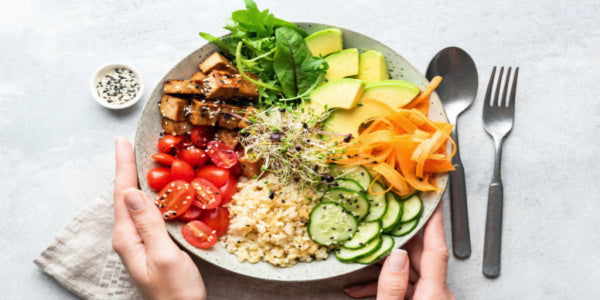
If you’re wondering how to lose weight without counting calories, you aren’t alone. It’s easy to get obsessive about counting calories and lose track of overall wellness goals.
Weight loss without calorie counting can encourage a healthier mindset around eating and create sustainable changes in your diet. Read on to find out how to lose weight without counting calories.
Is Counting Calories Effective?
Calorie counting, especially through the lens of weight loss, may sound great at first. However, when you consider that your body may need more food or energy on one day and less on another, counting calories can get tricky. The best way to make sure your body is getting the energy it needs is to implement sustainable, healthy eating habits instead of a rigid system.
In other words, the amount of calories you need fluctuates day to day. Counting calories can result in over- or under-estimating what your body needs to thrive.
Additionally, studies have shown that reducing calories does not always equal a reduction in weight. Reducing calories may be effective for weight loss in the short term. However, lasting weight loss and maintaining a healthy weight are a result of more balanced, sustainable eating patterns.
How to Achieve Weight Loss Without Calorie Counting
Recent research has shown that counting calories can encourage eating disorders. Alternatively, practices like intuitive eating support a more holistic approach to health.
Intuitive methods of eating (i.e. paying attention to the body’s hunger cues) can promote a more balanced form of wellness. This can allow you to feel more connected to meaningful hunger cues in your mind and body, rather than focusing on a number (like total calories) to indicate health.
An optimal weight loss diet should account for the following to ensure long-term compliance:
• Affordable
• Efficient
• Healthy
• Nutritionally adequate
• Safe
5 Alternatives to Calorie Counting
Did you know that calorie counts aren’t exact? The Food and Drug Administration (FDA) actually allows for a 20% margin of error when it comes to calories.
Basically, calories are an estimate to begin with. They aren’t intended to be used as an exact science, but rather provide a baseline idea of the number of calories (energy) a food item contains.
If counting calories feels too restricting for you, try these five methods instead.
1. Focus On Balanced Meals
Balanced eating is a lot like balanced spending. Just because you have thousands of dollars doesn’t mean you have to spend it. With counting calories as a framework for diet, some people will eat more nutrient-poor food (i.e. cookies, ice cream, bacon) just because it “fits” within their calorie counts for the day.
A healthier approach is weight loss to remember that all food has calories and that those calories can be accompanied by nutrients you need. Try to pick foods that check both the “low-calorie” box and the “nutrient-rich” box. For example, vegetables and fruits can be low in calories while providing much-needed vitamins and minerals.
2. Include Lean Protein
Protein is important for weight loss, especially when focusing on lean forms. Lean cuts of meat and plant-based protein can provide crucial vitamins and minerals while keeping saturated fat and cholesterol levels low.
Healthy lean meats and protein for weight loss and health include:
• Lean cuts of beef, i.e. top or bottom round, eye of round, ground round, ground chuck
• Lean cuts of pork, i.e. top loin chop, roast, tenderloin
• Poultry with the skin removed, i.e. chicken, turkey
• Unsalted nuts, seeds, beans, or peas, i.e. sunflower seeds, almonds, chickpeas
• Seafood, i.e. salmon, trout, herring, scallops, shrimp, oysters
• Other options include eggs and tofu
3. Remember Fiber-Rich Carbs
Fiber is a type of carbohydrate that the body can’t digest. It has an important nutritional impact on the body by helping move things along in the digestive system. Eating carbohydrates that are rich in fiber can help improve digestion and support weight loss.
The following foods are examples of fiber-rich carbs to add to your diet today:
• Fruits and vegetables
• Legumes, i.e. peas, edamame, lentils
• Whole grains, i.e. oast, plain popcorn, quinoa, wheat
4. Have Healthy Fats
Foods like nuts and seeds can be higher in calories but also provide plenty of nutrients and healthy fats. One important thing to know about fats is that although they provide a higher amount of calories per gram (9 calories/gram, while carbohydrates and proteins provide 4 calories/gram), fats help you feel full for longer.
Healthy fats, like omega-3 fatty acids, can be satisfying while also helping manage hunger hormones and weight loss in a healthy way.
5. Represent Each Food Group On Your Plate
According to experts, how a meal is represented on the plate matters more than sticking to exact calorie consumption. Using resources like MyPlate or Harvard’s Healthy Eating Plate can help you move from where you are to where you want to be in your weight loss journey.
Learning about proper portion sizes and representing each food group on your plate in each of your meals can help support a more intuitive style of eating.
The Final Word On Weight Loss Without Counting Calories
While “weight loss” and “counting calories” seem connected in our culture, there are actually other ways to sustain healthy weight loss. For long-term success, focus on the five methods listed above.
Finding nutrient-rich foods you love and eating a balanced plate with all the food groups can be healthy ways to lose weight that aren’t as restrictive as counting calories.
References:
Benton D, Young HA. Reducing Calorie Intake May Not Help You Lose Body Weight. Perspect Psychol Sci. 2017;12(5):703-714.
Garzon R. MyPlate —The Protein Group: Go Lean With Protein. New Mexico State University. Published December 2018. https://pubs.nmsu.edu/_e/E143/index.html.
Koliaki C, Spinos T, Spinou M, Brinia ME, Mitsopoulou, et al. Defining the Optimal Dietary Approach for Safe, Effective and Sustainable Weight Loss in Overweight and Obese Adults. Healthcare. 2018;6(3):73.
Plowe K. The 11 Best Lean Animal Proteins, According to a Dietitian. Livestrong. Published May 2022. https://www.livestrong.com/slideshow/1011094-13-lean-animal-proteins/.
Romano KA, Becker MAS, Colgary CD, Magnuson A. Helpful or harmful? The comparative value of self-weighing and calorie counting versus intuitive eating on the eating disorder symptomology of college students. Eat Weight Disord. 2018;23:841–848.
Valente L. Why I Don’t Believe In Calorie Counting, According to a Dietitian. EatingWell. Published April 2021. https://www.eatingwell.com/article/7898359/why-i-dont-believe-in-calorie-counting-according-to-a-dietitian/.







